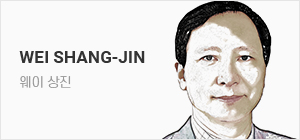

Strong productivity gains in the information and communication sector and professional and business services are boosting the US economy. Nonfarm business sector output per hour was up nearly 3% in the first quarter of this year compared to a year ago. While cyclical factors, including a sizeable fiscal stimulus, have contributed to the rebound, structural factors also seem to be at play. Business applications have jumped in the wake of the COVID-19 pandemic and remain high, including for businesses with growth potential. High-tech companies strongly contribute to this revival of business dynamism. Soaring manufacturing investment, spurred by government incentives, promises further productivity gains. Artificial intelligence (AI) could further raise growth, although estimates about its economy-wide impact vary widely.
We may be at the start of a new technology-led expansion, like the one associated with the diffusion of the internet economy, which lifted annual US nonfarm labour productivity growth to 3% on average between 1996 to 2005, compared to an average of 2.1% from 1947 to 2023 and a mere 1.5% since 2006. Financial markets seem to bet on a boom scenario, as evidenced by the high valuations of Big Tech stocks. History shows that the translation of technological advances into economic growth is uncertain, and often accompanied by economic and financial booms and busts. Many inventions, such as early electricity-based technologies and computers, took decades to deliver their full economic impact, as technological diffusion requires deep changes in production processes, business organisation and consumer behaviour. In any case, expanding digitalisation and the environmental transition will require considerable computing power. The Boston Consulting Group and Semiconductor Industry Association (BCG-SIA) project semiconductor production capacity to more than double from 2022 to 2032.
Thus, global economic growth is highly dependent on the efficiency and resilience of the extremely complex global semiconductor supply chain, which is vulnerable to disruptions. As chips are critical inputs for most industries, supply shortages can have a major economic impact. As an illustration, semiconductor shortages in the wake the COVID-19 pandemic hindered the activity of various downstream sectors, including information and communication technology, electronics, and motor vehicles, slowing the economic recovery around the world and contributing to global inflation. Events such as natural disasters, power supply failures, industrial accidents or cyberattacks on key semiconductor component production sites can temporarily affect the global supply of chips, resulting in significant economic losses worldwide.
| ||
| Visitors looking at AI chips at the 2023 World Artificial Intelligence Conference in China. Competition for AI chips is getting fierce. [Reuters] |
Furthermore, rising geopolitical tensions are challenging the semiconductor industry. The production of chips is very concentrated geographically, with East Asia (including China) accounting for about three quarters of the world‘s total. Concentration is even stronger for the most advanced chips, which are used in AI models, defence systems, critical infrastructure, and self-driving cars. Taiwan accounts for nearly 70% of the global production of chips smaller than 10 nanometers (nm), with Korea producing most of the remainder. Amid mounting rivalry for military and technological supremacy between the United States and China, and with the latter claiming Taiwan as part of its territory, dependence on the island for advanced semiconductors has become a serious concern.
Major economies are now seeking to diversify their sources of advanced chips and to raise production on their own soil. The 2022 US Chips and Science Act provides large subsidies to semiconductor manufacturers. Taiwan‘s TSMC, Korea’s Samsung and US‘ Intel are all building new chip factories in the United States. As a result, the BCG-SIA projects that the United States will account for close to 30% of the global advanced chips production by 2032. The European Chips Act is also triggering investments in manufacturing, albeit on a much smaller scale, and the Japanese
government is ramping up its support to the industry. Altogether, sources of advanced chips will diversify, with more than 40% of the production capacity expected to be located outside Taiwan and Korea by 2032, even as these countries keep expanding their own capacities. This multiplication of production sites will greatly enhance the resilience of the semiconductor supply chain, although at the price of increased risks of oversupply and some cost increases, due to reduced economies of scale and the necessity to reshape production ecosystems.
| ||
| ASML engineers working on photolithography machinery in a "clean room." Photo courtesy of ASML. Source ASML |
However, geopolitical tensions and economic fragmentation carry further risks for the semiconductor industry and the global economy. Even if building new manufacturing plants in different locations reduces bottlenecks, the whole supply chain still depends on collaboration and trade across continents, as production relies on highly specialised inputs concentrated in a few places. For example, about 90% of the graphics processing units (GPU) powering AI models are designed by Nvidia in the United States and produced by TSMC in Taiwan, which uses unique extreme ultraviolet (EUV) lithography machines produced by the Dutch company ASML that require inputs from more than 5,000 suppliers. Many other specialised inputs, from chip design software to chemicals, are involved at some stage of the manufacturing process. Such extreme specialisation means that for any region self-sufficiency is almost unattainable within reasonable time. Even if it proved feasible, BCG-SIA estimates suggest that full self-sufficiency in the main world regions would raise semiconductor prices by 35% to 65%.
The challenge facing policymakers is to find the right balance between national security and resilience considerations on the one hand and preserving a highly efficient supply chain based on international specialisation on the other hand. The international division of labour has allowed tremendous progress in computing power and large cost reductions over the past three decades, with huge spillovers to the wider economy. Most recently, it has enabled the rapid improvement of AI models. One difficulty is the dual use of the most advanced technologies, which can enter both civilian and military applications. Well-designed policies aimed at limiting the diffusion of cutting-edge technology to strategic rivals, while keeping up trade in non-strategic areas, should be able to protect national security interests at reasonable economic costs. However, in a world of mounting protectionism, there is a significant risk that obstacles to trade go well beyond what is justified by security reasons, which would further heighten geopolitical tensions, and threaten global prosperity.
| ||
| SMIC employees dressed in dust-proof clothing work at a Beijing chip plant of SMIC. [Reuters] |
Most countries would be severely hit by a dislocation of the global semiconductor supply chain, albeit in different ways. China would face the toughest challenge, at least in the short run, as its economy strongly depends on exports and its industry still lags in the most advanced technologies. It is already facing restrictions from the west on imports of advanced chips and key inputs needed for their production. Despite some progress, China looks unlikely to meet the ambitious 70% semiconductor self-sufficiency objective set out in the Made in China 2025 plan. While the production of 7nm chips by SMIC for Huawei in 2023 surprised many experts, most doubt that they can be produced at scale and at competitive prices, as China lacks access to cutting-edge lithography machines. New restrictions on trade would slow China‘s GDP growth, which is already weakened by a deep property crisis.
The United States is more resilient, as it controls, with its allies, most of the bottlenecks in the semiconductor supply chain, even though China dominates the production of some key minerals and rare earths. A total withdrawal from the Chinese market would nevertheless significantly reduce the US semiconductor sector‘s revenue, which could weaken its ability to innovate. Smaller economies of scale would raise costs, which would slow digital adoption, leading to weaker productivity growth.
Other technology leaders, such as Korea and Taiwan, and manufacturing hubs like Vietnam, could benefit from the strong demand for chips and the ongoing reshuffling of the semiconductor supply chain through higher exports, more investment at home, or foreign investment opportunities. However, dealing with geopolitical uncertainty is challenging in an industry that requires massive capital and R&D investments. Obstacles to trade also risks widening the digital gap between advanced and developing countries.
In sum, global economic growth depends heavily on a very efficient, but also vulnerable international semiconductor supply chain. Diversifying sources of critical inputs will increase the resilience of the chips industry and the global economy. But an escalation of geopolitical rivalries and protectionism would seriously hurt one of the main engines of global economic growth.
※The views expressed in this column are those of the author and not of the OECD or of its member countries.
CHRISTOPHE ANDRÉ
Senior economist, OECD
Since joining the OECD in 1997, he has produced analysis and policy advice in various areas, including macroeconomics, economic modelling and forecasting, fiscal and monetary policy, as well as health and housing economics. He has contributed to several editions of the OECD Economic Outlook and to many other OECD and academic publications. He has also headed the OECD‘s Finland, Korea, Sweden, and United Kingdom country desks. He is now part of the structural policy analysis division of the OECD Economics Department. His current research interests include international economics, productivity, population ageing, the economic impact of artificial intelligence, and housing economics.


세계 경제와 반도체 공급망의 약한 고리
정보통신 부문과 전문·비즈니스 서비스의 견조한 생산성 향상이 미국 경기를 부양하고 있다. 비농업 부문의 시간당 생산량은 올해 1분기에 전년 대비 3% 가까이 증가했다. 대규모 경기부양책을 비롯한 각종 순환 요인이 반등에 기여했지만, 구조적 요인도 작용하는 모습이다. 성장 잠재력이 있는 비즈니스를 비롯한 비즈니스 애플리케이션이 코로나19 팬데믹을 거치며 급격히 늘어난 뒤 여전히 높은 수준을 유지하고 있다. 첨단기술 기업들이 이런 비즈니스 역동성의 부활에 큰 몫을 하고 있다. 정부 인센티브가 불씨를 지핀 제조업 투자의 급증에서 추가적인 생산성 향상을 기대해 볼 수 있다. 인공지능(AI)이 경제 전반에 미치는 영향은 추산에 따라 천차만별이지만, AI 역시 성장을 한층 더 부채질할 수 있다.
1996~2005년, 미국의 연간 비농업 노동생산성 성장률을 평균 3%(1947~2023년 사이에는 평균 2.1%, 2006년 이후에는 단 1.5%였다)로 끌어올렸던 인터넷 경제의 확산 때처럼, 지금 우리는 새로운 기술 주도 확장기의 문턱에 와 있는지도 모른다. 금융시장은 빅테크 주식을 고평가하고 있다. 붐(Boom)을 확신하는 모양새다. 역사를 돌이켜보면 기술적 진보가 경제 성장으로 연결되는지는 불확실하지만, 그 과정에서 경제와 금융의 호황과 불황이 동반되곤 한다. 초기의 전기 기반 기술과 컴퓨터처럼 많은 발명품이 그 경제적 영향력을 제대로 발휘하는 데까지 수십 년이 걸렸다. 기술이 전파되려면 생산 공정, 기업 조직, 소비자 행동에 근본적인 변화가 필요하기 때문이다. 어쨌든 디지털화의 확산과 환경적 변화는 막대한 컴퓨팅 파워를 요구할 것이다. 보스턴컨설팅그룹과 미국반도체산업협회(BCG-SIA)는 2022년부터 2032년까지 반도체 생산능력이 두 배 이상 증가할 것으로 전망했다.
따라서 세계 경제성장은 고도로 복잡하며 붕괴에 취약한 세계 반도체 공급망의 효율성과 회복탄력성에 크게 좌우된다. 반도체 칩은 대부분의 산업에서 중요한 요소인 만큼, 공급 부족은 큰 경제적 영향을 미칠 수 있다. 일례로 코로나19 팬데믹으로 인한 반도체 부족은 정보통신기술, 전자기기, 자동차 등 여러 다운스트림(downstream·전방산업) 부문의 활기를 떨어뜨리고, 전 세계의 경제회복을 더디게 만들었으며, 글로벌 인플레이션을 부추겼다. 자연재해, 전력공급 중단, 산업재해, 주요 반도체 부품 생산지에 대한 사이버 공격 등 각종 사건은 전 세계 칩 공급에 일시적인 영향을 주어 세계 곳곳에서 상당한 경제적 손실을 초래할 수 있다.

게다가 깊어지는 지정학적 갈등은 반도체 산업의 도전 과제다. 칩 생산은 동아시아(중국 포함)가 세계 총생산의 약 4분의 3을 차지하는 등 지리적으로 매우 편중돼 있다. AI 모델, 방위 시스템, 중요 인프라, 자율주행 자동차에 사용되는 최첨단 칩의 경우 이러한 편중 현상은 더욱 심각하다. 전 세계 10나노미터(nm=10억분의 1m) 이하 칩의 약 70%가 대만에서, 그리고 나머지 대부분이 한국에서 생산된다. 미국과 중국 간의 군사·기술 우위 경쟁이 고조되고, 중국이 대만을 자국 영토라고 주장하는 상황에서, 첨단 반도체의 대만 의존은 심각한 문제가 됐다.
주요 경제국들은 현재 첨단 반도체의 공급원을 다각화하고 자체 생산을 늘리기 위해 애쓰고 있다. 미국은 2022년 반도체·과학법(Chips and Science Act)을 통해 반도체 제조사들에 막대한 보조금을 지급한다. 대만의 TSMC, 한국의 삼성, 그리고 미국의 인텔까지 모두 미국에 새로운 반도체 공장을 짓고 있다. 그 결과 BCG-SIA는 2032년까지 미국이 전 세계 첨단 반도체 칩 생산의 30%가량을 차지하게 될 것으로 전망했다. 유럽반도체법(European Chips Act) 역시 규모는 미국에 훨씬 못 미치지만, 제조 분야 투자를 촉진하고 있으며, 일본 정부는 반도체 산업에 대한 지원을 확대하고 있다. 설령 대만과 한국이 자국의 생산능력을 확충한다고 하더라도, 전체적으로 첨단 반도체의 공급원이 다각화되면서 2032년이면 생산능력의 40% 이상이 이 두 나라 밖에 위치하게 될 것으로 보인다. 이렇듯 생산 지역이 늘어나면, 규모의 경제가 줄어들고 생산 생태계를 재편해야 함에 따라 과잉 공급과 비용 상승의 위험이 커지겠지만 반도체 공급망의 회복탄력성은 뚜렷이 개선될 것이다.

그러나 지정학적 긴장과 경제적 파편화는 반도체 산업과 글로벌 경제에 또 다른 위험을 몰고 온다. 다양한 지역에 새로운 제조 공장을 건립함으로써 병목현상이 줄어든다고 하더라도, 생산은 고도로 전문화되고 일부 지역에 집중된 투입물에 의존하는 만큼, 전체 반도체 공급망은 여전히 대륙 간의 협력과 무역에 좌우된다. 가령, AI 모델에 사용되는 그래픽 처리 장치(GPU)의 약 90%는 미국의 엔비디아가 설계하며, 대만의 TSMC가 생산하고, TSMC는 네덜란드 기업 ASML의 자체 극자외선(EUV) 노광장비를 사용하며, 이 장비는 5000개 이상의 공급업체에서 조달받는 구성품이 필요하다. 그 외에도 칩 설계 소프트웨어에서 화학물질에 이르기까지 수많은 전문적인 재료가 제조 공정의 어느 단계엔가 들어간다. 이런 극도의 전문화는 어떤 지역도 합리적인 시간 안에 자급자족을 달성하기가 거의 불가능함을 뜻한다. 혹여 실현 가능성이 입증되더라도 BCG-SIA의 추정에 따르면 세계 주요 지역에서 100% 자족 자족을 달성할 경우 반도체 가격은 35~65% 상승할 것이다.
정책 입안자들이 당면한 문제는 국가 안보와 회복탄력성에 관한 고민거리 간에 적절한 균형점을 찾는 한편 국제적인 전문화에 기반한 고효율의 공급망을 보존하는 것이다. 국제 분업은 지난 30년간 컴퓨팅 파워의 비약적 발전과 비용의 대폭적인 축소를 가능하게 했으며, 경제 전반에 큰 파급효과(spillover)를 주었다. 가장 최근에는 AI 모델의 빠른 향상에도 기여했다. 한가지 난점은 첨단 기술의 민군 겸용성, 즉 첨단 기술이 민수용과 군수용 애플리케이션 모두에 적용될 수 있다는 점이다. 첨단 기술이 전략적 경쟁자에 전파되는 것을 제한하면서 동시에 비전략 영역에서는 무역을 유지하기 위한 적절한 정책을 마련한다면 합리적인 비용에 국가안보의 이익을 보호할 수 있을 것이다. 그러나 세계적으로 보호주의가 고조되면서, 안보를 이유로 정당화될 수 있는 수준을 넘어선 무역장벽이 생길 상당한 위험이 도사리고 있다. 그렇게 되면 지정학적 갈등의 골은 더욱 깊어지고 세계의 번영은 위협받게 될 것이다.
그 방식에는 차이가 있겠지만 대부분의 국가는 세계 반도체 공급망의 재편으로 심각한 타격을 받을 것이다. 중국은 경제의 수출 의존도가 매우 높고, 산업이 여전히 대부분의 첨단 기술에서 뒤처져 있기 때문에 적어도 단기적으로는 가장 힘든 난관을 만날 것이다. 중국은 이미 첨단 반도체와 그 생산에 필요한 핵심 투입물의 수입에서 서양의 각종 제재조치를 받고 있다.

일부 진전도 있었지만, 중국은 중국제조 2025(Made in China 2025) 계획에서 밝힌 반도체 70% 자급자족이라는 의욕적 목표를 달성하지 못할 것으로 보인다. 2023년 SMIC(中芯國際·중신궈지)가 화웨이의 7nm 칩을 생산한 일은 많은 전문가를 놀라게 했지만, 대부분은 중국이 최첨단 노광장비 이용에 한계가 있는 만큼 이 칩이 충분한 규모와 경쟁력 있는 가격으로 생산될 수 있을지에는 의문을 던진다. 새로운 무역 제재조치는 심각한 부동산 위기로 이미 흔들리는 중국의 GDP 성장을 더욱 둔화시킬 것이다.
중국이 일부 핵심 광물과 희토류의 생산을 장악하고 있지만, 미국은 동맹들과 함께 반도체 공급망의 병목현상 대부분을 통제하고 있기 때문에 회복 탄력성이 더 크다. 그렇지만 중국 시장에서 완전히 철수하게 되면 미국 반도체 부문의 수익이 곤두박질칠 것이며, 이는 미국 반도체 부문의 혁신 능력을 저해할 수 있다. 규모의 경제가 줄어들면 비용이 상승하고, 이것은 디지털 채택을 둔화시켜 생산성 증가율을 약화할 것이다.
한국, 대만과 같은 다른 기술 선도국과 베트남 등의 제조 허브국은 수출 신장, 국내 투자 확대 혹은 외국인 투자 기회를 통해 높은 반도체 수요와 현재 진행 중인 반도체 공급망 재편의 이익을 누릴 수 있다. 그러나 엄청난 자본과 연구개발 투자가 필요한 산업에서 지정학적 불확실성이란 대처하기 어려운 과제다. 무역 장벽 또한 선진국과 개발도상국 사이의 디지털 격차를 키울 위험이 있다.
종합해 보면, 세계의 경제성장은 매우 효율적이지만 한편 취약한 국제 반도체 공급망에 크게 의존하고 있다. 핵심 요소들의 공급원을 다각화한다면 반도체 산업과 세계 경제의 회복탄력성이 증가할 것이다. 그러나 지정학적 경쟁 구도와 보호주의가 짙어진다면 세계 경제 성장의 핵심 엔진 하나가 심각한 타격을 입을 것이다.
※ 본 칼럼에 포함된 의견은 저자의 의견이며, OECD 혹은 그 회원국의 의견이 아닙니다.
크리스토프 앙드레 프로필
OECD 수석 이코노미스트
1997년 OECD에 입사한 이래 거시경제학, 경제 모델과 예측, 재정통화정책, 보건,주택경제 등 다양한 분야에서 분석과 정책 자문을 제공해 왔다. 여러 판의 OECD Economic Outlook과 OECD 학술 간행물에 기고했다. OECD 핀란드, 한국, 스웨덴, 영국 경제 담당관을 역임했다. 현재 그는 OECD 경제학부의 구조 정책 분석 부서에서 일하고 있다. 그의 관심 분야는 국제 경제, 생산성, 고령화, AI가 경제에 미치는 영향, 주택 경제학 등이다.















